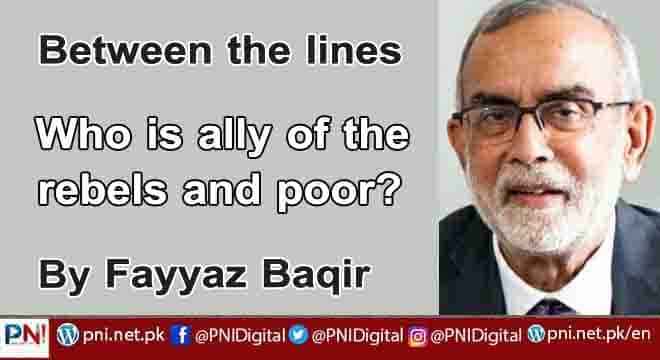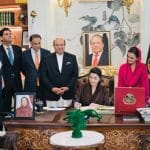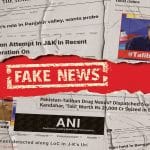UseAfter the arrival of the British, the world’s largest canal system was established in our country. Between 1885 and 1925 millions of acres of canal irrigated land were given to a new class of landowners. There was an abundance of wheat and cotton. But large tracts of agricultural land were held by absentee landowners. They did not know how to do business profitably. After independence in 1947, wheat became expensive and hunger became cheaper. The situation was the same in the rest of Asia, so the bells of revolution started ringing across the length and breadth of Asia. And Robert McNamara, the U.S. secretary of state and at one time the World Bank president, said “hunger is the communists’ biggest ally in Asia”. To break this alliance, the technology of the green revolution was introduced so that bread could be provided cheaper and the ghost of revolution could be defeated.
But before the green revolution came, the situation in Pakistan worsened. Habib Jalib wrote in his famous poem Sadr Ayub Zindabad that
Flour is sellinhg twenty rupees a maund
but there is dead silence all around
Gohar Sehgal, Adamji have turned into
the houses of Birla and Tata
When we cry out
We are called enemies of the country.
Long live President Ayub
This poem set fire to the length and breadth of the country. And before the spread of Green Revolution, Ayub Khan had to pack away from the corridors of power. After Ayub Khan’s departure, provision of bread to the poor became a big slogan in the 1970 elections. It sent panic waves panic among Pakistan’s traditional politicians. They started saying that the demand for bread meant abandoning spirituality. Nawabzada Nasrullah Khan said in a public meeting that even a bull eats bread, so demand for bread brings people down to the level of animals. As hunger was also considered a communist ally the demand for bread was seen as their unholy conspiracy. That is why The Islami Jamiat Students raised slogans in the midst of the elections.
Wake up Muslim wake up, run away, run away communist run away
It is a tragedy that Baba Farid Shakarganj, the Master who introduced Sufism to this region in the 11th century, was describing roti as the sixth member of the faith, and 20th-century Muslim theorists were calling it a threat to spirituality. After the elections, the PPP set up roti (bread making ) plants in cities and issued ration cards to low-income people so that they could buy cheap flour from government depots. This trend ended later but the campaign to eradicate poverty continued. In 1982, two non-governmental sector programs were launched that showed a sustainable path to poverty alleviation. These include the Aga Khan Rural Support Program in the northern areas and the Orangi Pilot Project in Karachi. They present the best example of changing the lives of citizens without slogans and protests and by unleashing the productive potential of the poor..
The Aga Khan Rural Support Programme’s (AKRSP) method was so simple and effective that India also launched a massive poverty alleviation program based on the same method. The program team used to ask the people of each village to tell a project whose completion would eliminate the poverty of the large population of the village. The priority that people identified was converted into local development plan. People were trained to complete the project themselves and manage it themselves. This closed the way for pilferage of resources. In a span of 10 years, this work doubled the income of 100,000 households in the most difficult mountainous villages. The program is now working in more than 130 districts of Pakistan.
In 1982, in Orangi, the largest slum in Karachi, Dr. Akhter Hameed Khan was asked to help carry out work towards poverty alleviation. Here too, he found a way to eradicate poverty with the help of people. He toured the streets of Orangi for six months and found that the cost of treatment for diseases was the biggest cause of poverty. All these diseases are caused by drinking contaminated water. Water is contaminated beacuse waste coming out of the houses accumulates in pits outside the houses and causes numerous diseases. If a sewerage line is put in every street, this problem will be solved. By spending less than half of the money that each household spends on treatment, they will put a sewerage line all over the street. It took another six months to explain the logic. Then the people took sanitation infrastructure development work at the lane level into their hands. And put sewerage lines in 7000 streets.
You’d think it’s for big organizations to do such work – what can a single person do? The story of a young social worker from village Chanari isa good example to learn from . When she started work in her area se went to an old woman’s house. The old lady said “My young son has died,” Thee daughter-in-law takes care of the children and cannot go out of the house and work. I’m old. Help me”. The social worker said, ” I will give three goats at your house. You will feed and milk them. I will give you five chickens. You will sell their chicks and eggs. I will give you seed to grwo cucumbers and vegetables. Every Every month we can repay the loan in installments. We can run your business from home. There should be no hunger here. Will that work? Yes, said the old woman. All the three stories narrated above have one common lesson, organization, credit and skills are major ally of the people in fighting poverty.
Follow the PNI Facebook page for the latest news and updates.








